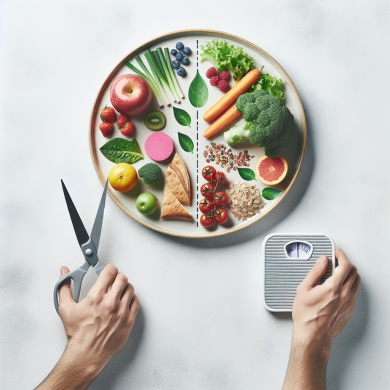Effortless Low-Calorie Meal Prep Strategies
Introduction
In today’s fast-paced world, maintaining a healthy diet can be challenging. With busy schedules and the convenience of fast food, it’s easy to overlook nutrition. However, with the right strategies, meal prepping can be an effective way to ensure you consume low-calorie, nutritious meals throughout the week. This article provides a comprehensive guide to effortless low-calorie meal prep strategies that can help you stay on track with your health goals without spending countless hours in the kitchen.
The Importance of Meal Prep
Meal prep is a powerful tool for anyone seeking to improve their diet. By planning and preparing meals in advance, you can control portion sizes, ensure balanced nutrition, and avoid the temptation of unhealthy convenience foods. For those focusing on low-calorie diets, meal prep becomes even more critical as it allows for careful calorie management while ensuring you still get the nutrients your body needs.
Essential Tools for Efficient Meal Prep
Before diving into meal prep, it’s crucial to have the right tools. Investing in quality containers, a reliable set of measuring cups, a food scale, and a sharp knife can make the process smoother and more efficient. Consider using glass containers for storage as they are microwave safe and don’t retain odors.
Containers
Choose containers that are stackable and come in various sizes. This allows you to store different portion sizes conveniently. Opt for airtight containers to keep your meals fresh for longer periods.
Food Scale
A food scale is essential for accurately measuring portion sizes. This is especially important for low-calorie meal prep, where controlling portion sizes is key to managing calorie intake.
Sharp Knife
A sharp knife speeds up the process of chopping and slicing ingredients. It enhances efficiency and safety, reducing the risk of kitchen accidents.
Planning Your Meals
Successful meal prep begins with effective planning. Determine the number of meals you need for the week, considering breakfast, lunch, dinner, and snacks. Create a menu that incorporates a variety of foods to ensure nutritional balance and prevent meal fatigue.
Calorie Calculation
Start by calculating your daily caloric needs based on your weight management goals. There are numerous online calculators available to help you determine this number. Once you have your daily target, divide it among the meals you plan to prepare.
Recipe Selection
Choose recipes that are both low in calories and rich in nutrients. Focus on incorporating lean proteins, whole grains, and plenty of vegetables. Consider recipes that can be easily scaled up or down based on your calorie needs.
Efficient Shopping Tips
Once your menu is planned, create a detailed shopping list. This not only saves time but also prevents impulse purchases that might derail your low-calorie intentions.
Stick to the Perimeter
The perimeter of the grocery store is typically where fresh produce, meats, and dairy are located. Focus your efforts here for healthier options, steering clear of the processed foods often found in the center aisles.
Buy in Bulk
Purchase staple items like grains, legumes, and proteins in bulk to save money. Not only is this cost-effective, but it also ensures you always have key ingredients on hand.
Prepping Techniques for Low-Calorie Meals
Prepping techniques can make or break your meal prep experience. By mastering a few key techniques, you can make your low-calorie meal prep both effective and enjoyable.
Batch Cooking
Batch cooking involves preparing large quantities of specific ingredients or entire meals in one go. For example, cooking a pot of quinoa or roasting a tray of vegetables can be used in various meals throughout the week.
Chop Once, Use Multiple Times
Chop vegetables and fruits in bulk and store them in airtight containers. This reduces prep time for individual meals and ensures you always have healthy snacks ready.
Utilize Freezer-Friendly Recipes
Choose recipes that freeze well. Soups, stews, and casseroles can be prepared in advance and stored in the freezer for those days when cooking feels impossible.
Incorporating Variety and Flavor
One of the challenges of meal prep is avoiding monotony. It’s essential to incorporate variety and flavor to keep meals exciting and enjoyable.
Spice It Up
Use herbs and spices to add flavor without extra calories. Experiment with different seasoning blends to give each meal a unique taste.
Rotate Ingredients
While consistency is key, avoid using the same ingredients every week. Rotate your proteins, grains, and vegetables to create diverse meals that provide a wide range of nutrients.
Conclusion
Effortless low-calorie meal prep is achievable with the right strategies and mindset. By investing in essential tools, planning effectively, and using efficient prep techniques, you can create nutritious meals that align with your dietary goals. Remember to incorporate variety and flavor to keep your meals exciting and enjoyable. With these strategies in place, you’re well on your way to maintaining a healthy and balanced diet without the stress and time commitment often associated with meal prep.















Add comment